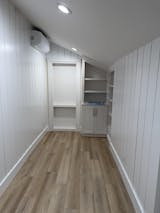Passthrough Clearance
Passthrough Clearance refers to the available space within a doorway that allows people, furniture, or other objects to move through safely and comfortably. In the case of a hidden double bookcase door, a portion of the doorway is occupied by the door's depth, leaving the remaining area known as "Passthrough Clearance."
In-Swing Bookcase Doors offer a bit more clearance than an outswing door. Please see charts below for both In-Swing and Out-Swing passthrough clearance.
*Important: Max Wall/ Jamb Depth for all In-Swing Bookcase Doors is 6-1/2" No restrictions on outswing doors
*Important: "Depth" is measured in overall depth (see in red on chart below), to determine actual shelf depth you must subtract 3/4" faceframe, backing, and 1/4" back trim.




